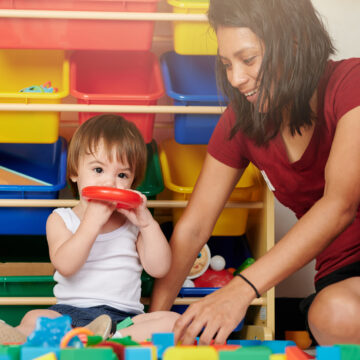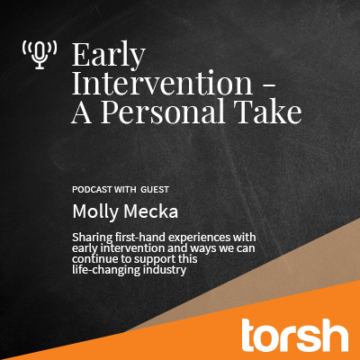Remember the bygone days of early intervention?
The practitioner would arrive carrying a bag stuffed with educational goodies. They’d spend the session pulling teaching tools from their bag, working with the child on much-needed skills. At the end of the session, the supplies would be packed up, and the practitioner would say goodbye until the next visit.
But what about the span between visits? Did the parents and caregivers have the knowledge and tools needed to practice the early intervention strategies that were demonstrated?
Generally, the answer was no.
That’s why early intervention coaching was developed — to enlist parents and caregivers as partners in achieving the goals of an early intervention plan.
We discuss how early intervention coaching helps families develop skills to support their child’s growth, and how coaching utilizes the child’s natural environment to create a place of collaboration and education.
Table of Contents
- What Is Coaching in Early Intervention?
- What Is the Main Goal of Early Intervention Coaching?
- How Can Caregivers Receive Early Intervention Coaching?
- What Does the Provider Do During Early Intervention Coaching?
- TORSH Talent: Professional Learning Platform for Early Intervention Coaching Providers
What Is Coaching in Early Intervention?
Early intervention coaching involves an early intervention coach working with a child’s caregivers to integrate developmental strategies into a family’s daily routines that will help a child make progress toward achieving their intervention plan’s goals.
Early intervention coaching views the caregivers as the experts on their child, and coaching is done in the child’s natural environment.
An Individualized Family Service Plan (IFSP) is at the heart of early intervention coaching and is provided to any child found eligible for early intervention services. An IFSP is an outcome-based road map developed by a team of …
- Parents
- Caregivers
- Professionals
- Early intervention providers
The IFSP outlines the services that will best help the child reach the desired outcomes, and describes …
- When
- How
- Where
… the services will be delivered.
In order to see progress, all early intervention coaching activities must be family-focused.
What Is the Main Goal of Early Intervention Coaching?
The goal of early intervention coaching is to help caregivers learn new ways to support a child’s learning with support and guidance from an early intervention practitioner.
This goal is achieved through:
- Ongoing observation of the child’s routines
- Conversations with the family and other caregivers
- Documentation of child and family history, interests, and strengths
- An understanding of family routines, goals, concerns, priorities, and resources
- Helping families learn new and appropriate routines to support the child’s development throughout the day
- Discussing the ways that best help the child learn
- Problem-solving and brainstorming issues and learning strategies
How Can Caregivers Receive Early Intervention Coaching?
Early Intervention is Part C of the Individuals with Disabilities Education Act (IDEA) and is generally offered for children from birth to three years of age. Depending on the state, older children may also be eligible for services.
Each state has a developmental assessment and qualifications a child must meet in order to receive services. When a child qualifies, they are referred for early intervention. During early intervention coaching, caregivers collaborate with a trained early intervention coach to learn how to best help the child.
Any caregiver of a child who qualifies for early intervention services may receive early intervention coaching.
What Does the Provider Do During Early Intervention Coaching?
Each state has different guidelines outlining the role the coach plays in the early intervention plan.
Some early intervention therapies might be center-based and have a group model. But ideally, coaching in early intervention takes place in the child’s natural environment, which may be:
- The child’s home
- Grandparents’ home
- Aunt or uncle’s home
- A foster care home
- Childcare facility
Some states have specific coaching therapy techniques, such as Family Guided Routines Based Intervention (FGRBI) which facilitates the collaboration of early intervention coaches and caregivers to engage young children in learning. This is done as caregivers participate in everyday activities and routines that are natural and meaningful to the child.
In today’s early intervention model, the provider is offering guidance and support through collaborative coaching. Early intervention coaching is a partnership. Here, the provider is stepping down from the role of “expert” and taking on the role of a “coach,” allowing the caregiver or parent to step into the “expert” position.
For example, Sasha is having difficulty making eye contact with her caregivers. The coach and caregiver collaborate to create a ball-rolling game to play with Sasha that incorporates making eye contact each time she catches the ball. The coach introduces the game, teaching the caregiver how to do the activity with Sasha. The caregiver plays the game with Sasha several times before the coach leaves so they are comfortable with the process. The caregiver then will continue the activity with Sasha throughout the week, noting any questions or concerns that may develop. These will be discussed during the next coaching session to improve as needed to best meet the developmental goals established in the IFSP.
Check-In
At the start of each early intervention coaching session, the coach will check in with the caregiver to get a feel for what’s going on that day or in the time since the last home visit and to understand the current emotional vibe.
- Has the child had a rough morning?
- Are they overly excited about a special event planned for later in the day?
- Is there emotional upheaval in the home?
- Has someone been ill?
The coach will also take a few minutes to ask questions, such as:
- “What do you want to work on today?”
- “Tell me about any progress you’ve seen.”
- “Have there been any setbacks or do you have any concerns?”
- “How is Sasha doing with the ball-rolling activity we did last week?”
In addition, it is important to consistently check in with families to get their input and help them reflect on how they could best use previous strategies.
Remain Flexible
When coaching parents and caregivers in early intervention, the coach must be flexible.
For example, as the coach is checking in with the parent or caregiver, they mention that all of a sudden Sasha has started banging her head on the floor.
Since this is a safety issue and a critical piece of information, all pre-planned coaching activities will immediately be tossed aside. The coach will instead ask questions about the new development to find out more, such as,
- “When did this behavior start?”
- “What happens immediately before and after Sasha begins banging her head?“
- “How do you respond to this new behavior?”
Maintaining flexibility allows the coach to address any unforeseen situations that may arise and to best meet the needs of the child and their caregivers.
Discover and Utilize the Caregiver’s Learning Style
Since early intervention coaching is family guided, it is critical you discover their learning style and leverage their strengths.
Is the caregiver’s learning style:
- Auditory
- Visual
- Kinesthetic
- Reading/writing
The coach is training the caregiver to work with the child and, by coaching in a way that aligns with the caregiver’s learning style, can help to ensure the caregiver is grasping the concepts being addressed.
Problem Solve With the Caregiver
Let’s revisit Sasha’s recent head banging during the ball activity.
Once the coach has investigated the details of the behavior, the caregiver and coach can work together to problem solve and come up with several possible solutions.
They may discuss the best time of day to practice, by asking questions such as:
- “Is Sasha a morning girl, or does she tend to do better in the late afternoon?”
- “Should the learning activities take place after she eats or takes a nap?”
The coach will then go through the revised plan several times to see how Sasha responds. Then the caregiver may take a turn if they feel comfortable doing so.
This collaborative problem solving enables the coach/caregiver team to rework strategies to best meet Sasha’s changing needs.
Hands-On Coaching
The coach will work with the caregiver hands on. They will describe and model activities, providing insight, as needed.
As the early intervention coach goes through each activity, they will describe:
- What they are doing
- Why they are doing it
- The impact of the strategy on the child
This gives the parent or caregiver the opportunity to see what the strategy looks like when it’s implemented with fidelity. The caregiver is encouraged to ask questions and offer suggestions to fine tune the activity to meet their child’s unique needs.
Next, the coach will encourage the parent to try the strategy themselves. This is a critical component in early intervention coaching since once the coach leaves, the caregiver is on their own until the next session. If the caregiver is not comfortable with the plan, the child won’t have the opportunity to benefit from the intervention until the coach returns.
Session Reflection and Review of the Plan
Finally, the coach and caregiver will wrap up by reflecting and reviewing what was covered during the session.
If the caregiver doesn’t feel comfortable or confident with the intervention, they’re not going to practice it with their child.
This is where the importance of the reflection piece comes into play. Reflection involves thinking back through the session — what skills were covered, how did the child respond, and what questions does the caregiver have.
The practitioner will review with the caregiver what they should work on with their child throughout the week.
The coach’s goal is to build the caregiver’s capacity This empowers the caregiver to feel comfortable and competent in working with the child on the identified skill deficits.
It’s important to remember that the caregiver is the expert on their child. They know best how the child communicates and functions from day to day. This is why establishing the caretaker’s competence during the reflection and review time is so valuable.
TORSH Talent: Professional Learning Platform for Early Intervention Coaching Providers
Early intervention coaches need coaching too… When practitioners record their sessions with families they can use the videos for self-reflection to improve their services and also share them with a coach or colleagues to get feedback. When working with young children, HIPAA compliance and data privacy and security are non-negotiable. Does your organization have a HIPAA and FERPA compliant platform to share video? And a way for practitioners and coaches to easily collaborate? Take a look at TORSH Talent.
We provide early intervention coaches with a simple to use, intuitive platform to provide time-stamped feedback on videos of practice and collaborate asynchronously or synchronously with practitioners to help them develop their practice and meet their goals.
Using TORSH Talent, practitioners and coaches can watch, listen to, and re-watch recorded early intervention coaching sessions with families in order to fine-tune their practice.
Click below to schedule a consultation and demo with one of our early intervention coaching specialists.



